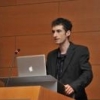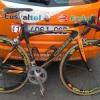Here is an interesting argument that deserve more attention. It also describes a new way of looking at how to treat cancer that is emerging from a combined understanding of stem cells and epigenetics. Yet the hypothesis is somewhat old, but it keeps emerging like its metaphor and it returns again and again after opponents think it is irradiated when new evidence arrives to support it.
Stem Cell Theory of cancer
Scientists Weigh Stem Cells’ Role as Cancer Cause
Fabrizio Costantini for The New York Times

Dr. Max S. Wicha, a leading researcher of cancerous stem cells.
By GINA KOLATA
Published: December 21, 2007
Within the next few months, researchers at three medical centers expect to start the first test in patients of one of the most promising — and contentious — ideas about the cause and treatment of cancer. The idea is to take aim at what some scientists say are cancerous stem cells — aberrant cells that maintain and propagate malignant tumors.
Although many scientists have assumed that cancer cells are immortal — that they divide and grow indefinitely — most can only divide a certain number of times before dying. The stem-cell hypothesis says that cancers themselves may not die because they are fed by cancerous stem cells, a small and particularly dangerous kind of cell that can renew by dividing even as it spews out more cells that form the bulk of a tumor. Worse, stem cells may be impervious to most standard cancer therapies.
Not everyone accepts the hypothesis of cancerous stem cells. Skeptics say proponents are so in love with the idea that they dismiss or ignore evidence against it. Dr. Scott E. Kern, for instance, a leading pancreatic cancer researcher at Johns Hopkins University, said the hypothesis was more akin to religion than to science.
At stake in the debate is the direction of cancer research. If proponents of the stem-cell hypothesis are correct, it will usher in an era of hope for curing once-incurable cancers. If the critics are right, the stem-cell enthusiasts are heading down a blind alley that will serve as just another cautionary tale in the history of medical research. In the meantime, though, proponents are looking for ways to kill the stem cells, and say that certain new drugs may be the solution.
“Within the next year, we will see medical centers targeting stem cells in almost every cancer,” said Dr. Max S. Wicha, director of the University of Michigan Comprehensive Cancer Center, one of the sites for the preliminary study that begins in the next few months (the other participating institutions are Baylor College of Medicine in Houston and the Dana-Farber Cancer Institute in Boston).
“We are so excited about this,” Dr. Wicha said. “It has become a major thrust of our cancer center.”
At the National Cancer Institute, administrators seem excited, too.
“If this is real, it could have almost immediate impact,” said Dr. R. Allan Mufson, chief of the institute’s Cancer Immunology and Hematology Branch.
The cancer institute is financing the research, he said, and has authorized Dr. Mufson to put out a request for proposals, soliciting investigators to apply for cancer institute money to study cancer stem cells and ways to bring the research to cancer patients. The institute has agreed to contribute $5.4 million. “Given the current fiscal situation, which is terrible, it’s a surprising amount,” Dr. Mufson said. “We actually asked for less,” he added, but the cancer institute’s executive committee asked that the amount be increased.
Proponents of the hypothesis like to use the analogy of a lawn dotted with dandelions: Mowing the lawn makes it look like the weeds are gone, but the roots are intact and the dandelions come back. So it is with cancer, they say. Chemotherapy and radiation often destroy most of a tumor, but if they do not kill the stem cells, which are the cancer’s roots, it can grow back.
Cancerous stem cells are not the same as embryonic stem cells, the cells present early in development that can turn into any cell of the body. Cancerous stem cells are different. They can turn into tumor cells, and they are characterized by distinctive molecular markers.
The stem-cell hypothesis answered a longstanding question: does each cell in a tumor have the same ability to keep a cancer going? By one test the answer was no. When researchers transplanted tumor cells into a mouse that had no immune system, they found that not all of the cells could form tumors.
To take the work to the next step, researchers needed a good way to isolate the cancer-forming cells. Until recently, “the whole thing languished,” said Dr. John E. Dick, director of the stem cell biology program at the University of Toronto, because scientists did not have the molecular tools to investigate.
But when those tools emerged in the early 1990s, Dr. Dick found stem cells in acute myelogenous leukemia, a blood cancer. He reported that such cells made up just 1 percent of the leukemia cells and that those were the only ones that could form tumors in mice. Yet Dr. Dick’s research, Dr. Wicha said, “was pretty much ignored.” Cancer researchers, he said, were not persuaded — and even if they had accepted the research — doubted that the results would hold for solid tumors, like those of the breast, colon, prostate or brain. That changed in 1994, when Dr. Wicha and a colleague, Dr. Michael Clarke, who is now at Stanford, reported finding cancerous stem cells in breast cancer patients.
“The paper hit me like a bombshell,” said Robert Weinberg, a professor of biology at M.I.T. and a leader in cancer research. “To my mind, that is conceptually the most important paper in cancer over the past decade.”
Dr. Weinberg and others began pursuing the stem-cell hypothesis, and researchers now say they have found cancerous stem cells in cancers of the colon, head and neck, lung, prostate, brain, and pancreas. Symposiums were held. Leading journals published paper after paper. But difficult questions persisted. One problem, critics say, is that the math does not add up. The hypothesis only makes sense if a tiny fraction of cells in a tumor are stem cells, said Dr. Bert Vogelstein, a colon cancer researcher at Johns Hopkins who said he had not made up his mind on the validity of the hypothesis.
But some studies suggest that stem cells make up 10 percent or even 40 percent or 50 percent of tumor cells, at least by the molecular-marker criterion. If a treatment shrinks a tumor by 99 percent, as is often the case, and 10 percent of the tumor was stem cells, then the stem cells too must have been susceptible, Dr. Vogelstein says.
Critics also question the research on mice. The same cells that can give rise to a tumor if transplanted into one part of a mouse may not form a tumor elsewhere.
“A lot of things affect transplants,” Dr. Kern, the Johns Hopkins researcher, said, explaining that transplanting tumors into mice did not necessarily reveal whether there were stem cells.
Other doubts have been raised by Dr. Kornelia Polyak, a researcher at the Dana-Farber Cancer Institute. Dr. Polyak asked whether breast cancer cells remain true to type, that is, whether stem cells remain stem cells and whether others remain non-stem cells? The answer, she has found, is “not necessarily.”
Cancer cells instead appear to be moving targets, changing from stem cells to non-stem cells and back again. The discovery was unexpected because it had been thought that cell development went one way — from stem cell to tumor cell — and there was no going back.
“You want to kill all the cells in a tumor,” Dr. Polyak said. “Everyone assumes that currently-used drugs are not targeting stem cell populations, but that has not been proven.”
“To say you just have to kill the cancer stem cell is oversimplified,” she added. “It’s giving false hope.”
The criticisms make sense, Dr. Weinberg said. But he said he remained swayed by the stem cell hypothesis.
“There are a lot of unanswered questions, mind you,” he said. “Most believe cancer stem cells exist, but that doesn’t mean they exist. We believe it on the basis of rather fragmentary evidence, which I happen to believe in the aggregate is rather convincing.”
Dr. Wicha said he was convinced that the hypothesis was correct, and said it explained better than any other hypothesis what doctors and patients already know. “Not only are some of the approaches we are using not getting us anywhere, but even the way we approve drugs is a bad model,” he said. Anti-cancer drugs, he noted, are approved if they shrink tumors even if they do not prolong life. It is the medical equivalent, he said, of mowing a dandelion field.
He said the moment of truth would come soon, with studies like the one planned for women with breast cancer. The drug to be tested was developed by Merck to treat Alzheimer’s disease. It did not work on Alzheimer’s but it kills breast cancer stem cells in laboratory studies, Dr. Wicha says.
The study will start with a safety test on 30 women who have advanced breast cancer. Hopes are that it will be expanded to find out if the drug can prolong lives.
“Patient survival,” Dr. Wicha said, “is the ultimate endpoint.”















































